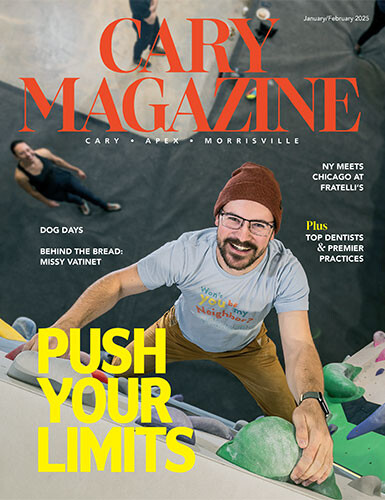140,000 — population of Cary in 2011 according to U.S. Census Bureau. 1,500 — population of Cary in 1957 according to Jerry Miller, who just that year put down roots in this “sleepy village” with his wife. Miller, and four other Cary loyals, provides a glimpse into life in Cary’s early years.
 Tom Byrd
Tom Byrd
When I moved here, there was a field of tobacco growing between Cary High School and downtown, on Walnut Street.
The town had two family doctors. One of them lived directly across the street from us and he became our family doctor for 29 years.
It’s sort of been official town policy to keep this a small-town, friendly atmosphere. That was the reason that such an effort has been made to preserve the center of town and to retain the character. You walk down Chatham Street or Academy Street, and sure there are changes, but it looks a lot like it did in 1962.
The centennial celebration (1971) really brought the town together. A lot of new people in town all joined in the celebration. It was good for building community spirit.
I think we had some very forward-looking leaders that got in control of growth and insisted on communities being well planned. It created the base for the very place that I’ve always been proud to live.
– Tom Byrd worked as a writer and editor for N.C. State University when he and his family moved to Cary in 1962. Town population, he recalls, was then near 3,500. Today, Byrd still lives in the same house. He wrote the town history book Around and About Caryand helped establish the Cary Heritage Museum at the Page-Walker Arts & History Center. Photographed at the Page Smokehouse behind the Page-Walker Arts & History Center.
 Bob Cassell
Bob Cassell
At first, there were more things that you couldn’t do. Cary was a teetotaling town; you couldn’t even buy a can of beer here. There was no mail delivery to the houses. You had to go to the post office and pick it up. There were only two doctors. There was one grocery store, a drug store and a few service stations and that was about it.
When I went into the post office in ’66 there was one rural route and four city routes. Now there’s around 75.
I used to know about everybody, particularly by being in the post office.
The first out of town mayor was a guy by the name of Bill Justice; he was a doctor. Up until that time (1961), the town had been totally run by the town fathers who had been here forever.
The planning board had to decide whether we were going to improve Harrison Avenue coming into Cary or North Academy. I always felt like I influenced the decision on having North Academy designed so you could see all the way through town with the school at the end.
Back in 1955 when I first got here, Cary was having a lot of water problems. Women would go up to the town council meeting with brown sheets and plop them down in front of the mayor. The town was operating off of wells. They had to run water lines to Raleigh.
– Bob Cassell came to Cary with his wife in a “covered wagon” in 1955. Cassell served Cary as a National Guardsman, town councilman, as a member of several town boards and as postmaster. One of the town’s early northern transplants, Cassell, from Connecticut, “slipped in” with his wife, a native of North Carolina. “Southern women don’t move north,” he said. Photographed at the U.S. Post Office Academy Street Station.
 Kay Earp
Kay Earp
I’ve kind of grown up with the town. I saw Cary for the first time when I was just 16 years old.
In the early days, Cary didn’t have anything. I think Johnson’s BBQ was here — it was the only eating place I can remember.
When I married Bob in 1961, the only shopping center was Cameron Village.
I’ve never worked off of Kildaire Farm Road. When people used to come, in say 1974, to buy a home we had maybe four real estate offices.
Bob Craddock, my late husband, he’s from a railroad family. Dab Craddock was his grandfather who was a railroading guy. His picture’s hanging in the depot now. Cary always had a little depot here. The town is full of rich history.
Cary’s full of wonderful people who love public service and who want to make it an even better community. It’s the perfect bedroom community. It’s so quaint. Don’t you think it’s just darling?
– Kay Earp first visited Cary to meet the family of her would-be husband. Settling here for good in 1972, Earp has been practicing real estate in Cary for 39 years. Falling in love with a town and its people, Earp cherishes the opportunity to help others find their homes in Cary. Photographed at the Ivey-Ellington-Waddell House.
 Jerry Miller
Jerry Miller
I always liked to draw. When I was in school, I was always drawing while the others were studying.
In 1957, Cary had one stoplight. We paid $11,000 for our house. Kildaire Farm was a dirt road when I moved to town.
Cary only had three city wells. They pumped it up in big tanks. One of those tanks wouldn’t take care of a subdivision now.
I remember Mr. R.O. Heater told us in the Jaycees one day, he said, ‘One day Cary will have 20,000 people.’
R.O. Heater was a fervent champion of Cary and one of the town’s first housing developers. Serving frequently as a town board member and as Wake County commissioner, he was known as Mr. Cary.
I went down to Cary Parks & Recreation and said, ‘Let’s do something for the people of Cary. Let’s start a street festival in Cary. … We’ll make money the first year and I’ll tell you how we’ll do it — we’ll sell spaces on the street and the revenue from that will more than pay for it.’ They liked that idea.
I said, ‘I’m setting the show up and you better believe we’re gonna be organized.’ I talked 100 vendors into coming … 100 the first year (1977)! We now have people coming from Florida, from New York, from Texas, from everywhere for a one-day show.
– Cary Chamber of Commerce Citizen of the Year, Herb Young Volunteer of the Year and Rotarian of the Year are just a few of the honors earned by Jerry Miller, founder of the Lazy Daze Arts & Crafts Festival, Cary resident and “walking Chamber of Commerce” since 1957. Miller, an artist, illustrated Around and AboutCary with pen and ink drawings of town buildings and landmarks. Miller still sells his artwork at Lazy Daze each summer. Photographed on Academy Street, in front of the Cary Arts Center.
 Peggy Van Scoyoc
Peggy Van Scoyoc
There were all these little old farmhouses that I passed on Davis Drive, on the way to work out in RTP. It was completely new to me coming from California. Of course they are all gone now.
When I came here, there was a much slower pace. The people were friendly and open. It was very easy to get involved in anything. I just felt at home almost immediately. When I retired there was no question I was staying here.
People took the train to Raleigh to shop, to work. Many people talked about how safe it was that small children, 7 and 8 years old, would leave the house on a Saturday morning and would get on the train and go to Raleigh. They would see a movie and get a sandwich then come back for dinner. … That kind of gives you a picture of what life must have been like in Cary way back when.
Cary voluntarily desegregated Cary High in September of 1963. It was the first school in the Wake County System that desegregated, and it became a model for how to in Wake County and all over the South. It was 50 years ago this year. Cary became a leader. We had a lot of brave people, and we have a lot to be proud of.
– Peggy Van Scoyoc moved to Cary from Silicon Valley in 1994 working as facilities manager for Cisco Systems. She sits on the board of directors for the Friends of the Page-Walker Hotel and has conducted close to 70 oral history interviews of Cary’s longtime residents. She authored two oral history books, Just a Horse-Stopping Placeand Desegregating Cary, both available at the Page-Walker Arts & History Center. Photographed at the Page-Walker Arts & History Center.




